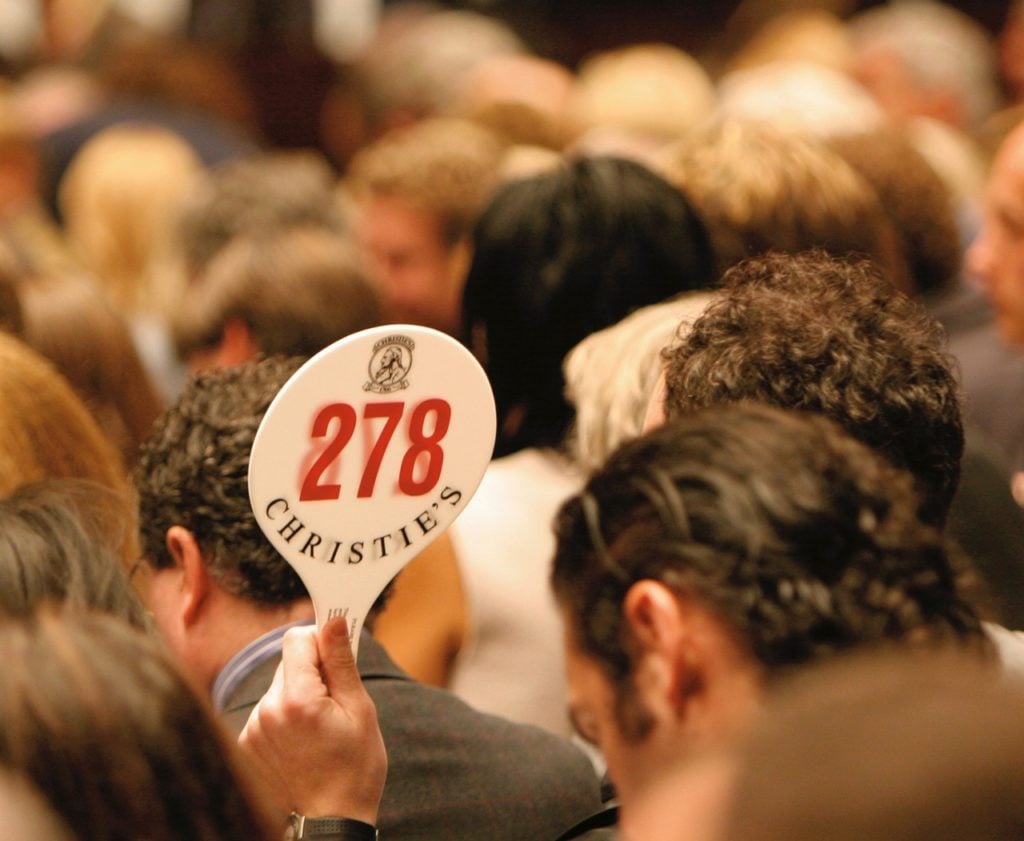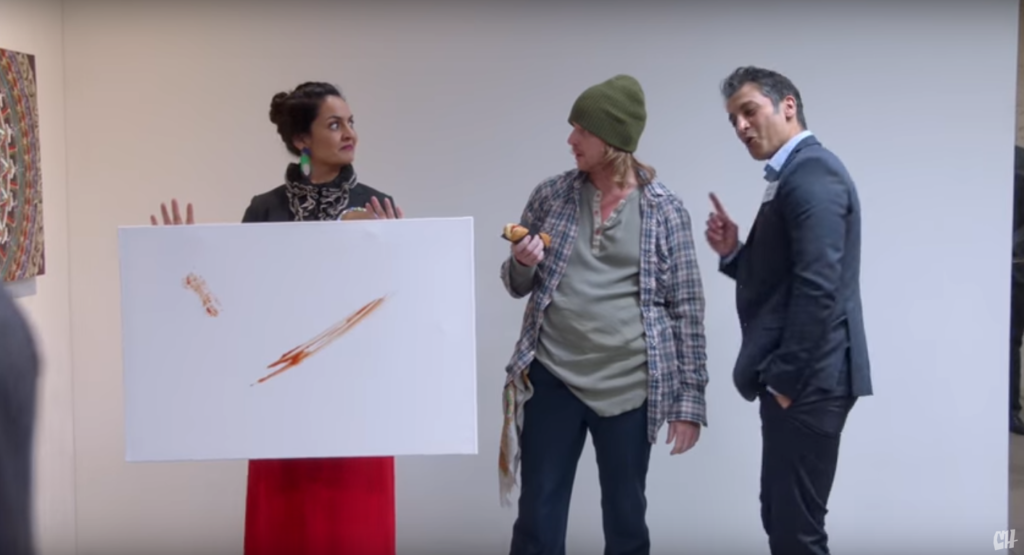How Is a Fine Art Jarket Is a Scam
Is the fine art market place no more than than a playground for snobs and crooks? The comedian Adam Conover certainly thinks and then. He makes the case in a five-minute video released yesterday as the latest in his web serial "Adam Ruins Everything." The segment, dripping with a Morley Safer-worthy level of contempt for the art globe, has already exceeded one meg views.
Conover's thrust is that the art market is hopelessly corrupt, and manipulated by a tiny conduce of oily dorsum-room wheeler-dealers who not simply make up one's mind the toll of art and rig the system to enrich themselves—they also define "what art is."
https://www.youtube.com/scout?v=NSdbASDdwU4&feature=youtu.be
Some of Conover's claims—which echo many complaints lobbed at the art globe in recent years—are amend-researched than others. A primary problem with the video is that "the art market" is described equally a monolith, but most in the art globe recognize that "the art marketplace" is in fact a constellation of mini-markets, and that the concern of a mom-and-pop shop bears little resemblance to that of an international behemoth like Gagosian. (Also, the stock marketplace isn't just populated by corporate raiders, inside traders, and Apple just also hundreds of millions of striving businesses operating with public investment.) The climactic claim that the corrupt marketplace determines "what art is" as well discounts the many practices that aim to wriggle gratuitous of capital (encounter: social practice, performance art, etc.)
But he'south non always wrong. Below, nosotros consider a handful of the creatively coiffed comedian'south claims.
i. Big Galleries Continue Prices Secret And so They Can Modify Them Depending on Who the Buyer Is.
Businesses in New York—including art galleries—are required by law to "clearly display" prices for their goods. In fact, hardly any Gotham galleries do so, though lawmakers take tried to crack down on this. That said, some galleries are open about money and will post, or at least disembalm, prices when asked. (Even so, many inflate the sticker toll past xx per centum and then knock it down to make the buyer feel he or she is getting a deal.)
As for adjusting what they accuse for dissimilar customers, galleries do offering varying discounts, and some buyers—a museum, say, or a collector similar Eli Broad with a reputation for ownership an artist's work long-term and in-depth—are more desirable than others.
Truth caliber: Mostly true.
two. Galleries Discriminate Against Novice Collectors… Like Poor Little Harry Potter.
To make the instance that dealers can be less than welcoming to potential buyers who aren't part of a villainous hole-and-corner society of art profiteers, Conover chooses the odd instance of Daniel Radcliffe, who was once spurned when he sought to purchase a work of art, Conover alleges, citing a written report in the New York Observer. Just Conover didn't read the whole story. As Radcliffe told the Guardian (and as cited past the Observer), the creative person in question, Jim Hodges, intervened and insisted the gallery sell to him. As well, a multimillionaire role player every bit the little guy? Again, strange choice.
Truth caliber: By and large bogus.
3. Auction Bidding Is All a Lie, Because Major Auction Houses "Directly-Upwardly Pay People to Bid" and Auctioneers Call Out Simulated "Chandelier Bids."
Yes, top-dollar auction sales have become complicated transactions, and a third party will sometimes privately make a bid on a work of art before the sale. If the piece of work ends up selling to a higher place that price, the third party gets a percentage of the upside. (This organisation is known as a "3rd-party guarantee.") Only even if it does open upwardly the door to the kind of cabalistic withal lucrative fiscal machinations that wealthy financiers specialize in, it's a flake drier and less "direct-upward" than the cartoon nefariousness portrayed in the video.
That said, the practice of "chandelier behest," in which an auctioneer calls out imitation bids during a live sale, is very much real. As an auctioneer inches closer to the minimum price for which a seller has agreed to function with a work (known as a "reserve"), he may bespeak to invisible eager bidders in the dorsum of the room. It's all part of an try to foster drama and conceal the true reserve cost, which sale houses say helps the consignor get the best possible outcome.
Both practices have been covered extensively in the New York Times, and a New York Land senator once introduced legislation to outlaw chandelier bidding.
Buyers at these high levels are generally familiar with what'southward happening—and the fine print at the back of the sales catalogues does acknowledge both these practices. But to a neophyte, such hieroglyphics and theatrics would legitimately seem impenetrable, and mayhap a little sketchy.
(Sotheby's and Christie's both declined to comment.)
Truth quotient: True at stratospheric price levels, otherwise mostly bogus.

Christie'south celebrate their 250th anniversary this month. Photo: courtesy Christie'due south.
4. Auction Houses Are a Corking Identify for Crooks to Defraud the Government and Launder Dirty Coin.
True, despite auction houses' all-time efforts (and they take phalanxes of lawyers trying to keep them out of trouble), some bad actors do buy art with muddied money. The United states Section of Justice last year brought a case confronting Malaysian tycoon Jho Low, alleging that he bought $137 million worth of art at auction, including a Basquiat and a Monet, with funds embezzled from the Malaysian authorities.
Conover asserts that collectors who donate artworks to museums are bad actors, too—they get a tax write-off for charitable donations, and, crucially, he says they can claim whatsoever value they want for the artworks on their revenue enhancement forms. Just the IRS isn't stupid, and has increasingly scrutinized these valuations. Private museums, which offering revenue enhancement benefits to their owner-donors, have likewise come under scrutiny.
Truth quotient: Partially correct, partly seriously bogus.

Two art dealers conspire to get rich off a hot canis familiaris-eating artist's "additive-based" piece of work. Photograph via YouTube.
five. You lot Can Buy Fine art on the Street That's Merely as Good equally What Yous Could Buy in a Gallery. Just Those Artists "Aren't Allowed to Succeed."
You lot can also find gold nuggets in a riverbed, only because the time information technology takes to find the right riverbed and learn the techniques for locating the gold, years of your life could accept passed by. Galleries are businesses run past specialists whose primary value proposition is that they know who good artists are, have relationships with them, and can cut through the chaff to go the cream of the foam.
Yes, the art world, like many businesses that serve the ane percent, runs on nepotism and connections. But these art dealers (and curators) are too constantly on the lookout for undiscovered talent. The clubbiness of the fine art market is more oft the issue of laziness or lack of resources than a nefarious pyramid scheme; tastemakers often autumn back on their existing networks rather than taking the considerably more difficult path of looking beyond them. That said, true talent is rare, and sometimes takes a long time to be properly recognized, either by museums or the art market place. Jean-Michel Basquiat started out as a graffiti writer, and now his works can sell at auction for up of $110 meg. Why wouldn't dealers create a 1000000 fine art stars from thin air, if they were such skilled manipulators?
Truth caliber: Bogus.
Conclusion
"So the fine fine art globe is all a lie, and it's all most money, and who gets into this stupid, bossy club," says Conover'due south foil in the video, a bright-eyed-until-disillusioned creative person, at the video's end. Intones Conover, "More or less."
So, are Conover'southward diagnoses on the coin?
Sometimes more, sometimes less.
Follow Artnet News on Facebook:
Desire to stay ahead of the art earth? Subscribe to our newsletter to get the breaking news, centre-opening interviews, and incisive critical takes that bulldoze the conversation forward.
Source: https://news.artnet.com/art-world/comedian-adam-conover-art-market-scam-1047887
0 Response to "How Is a Fine Art Jarket Is a Scam"
Post a Comment